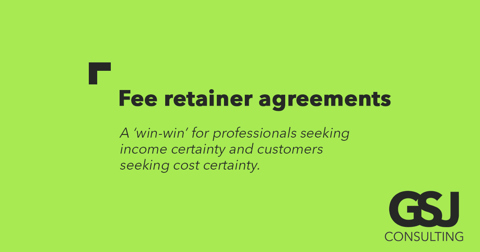Using retainer fee agreements to create client loyalty

Competition for work has never been greater. Every year I feel like the demand side shrinks, the supply side expands, and the cries of ‘more for less’ grow louder. One of the more innovative ways for professionals to create and cultivate client stickiness is to commit to a retainer fee arrangement.
Retainer fee arrangement explained
A retainer fee arrangement is a payment structure where the client agrees to pay you a fixed amount on a regular basis in exchange for the professional services you provide.
Often the period is monthly, but you do also see annual retainers.
Essentially, the client is securing your availability and then dedicating that availability to their needs.
Why retainer fee arrangements create client loyalty
-
Retainers create trust
One of the most important aspects of any professional relationship is trust. A retainer fee arrangement allows both the service provider and the customer to develop a deep and trustful relationship. It helps the customer feel secure in the knowledge that they have the professionals they want to do their work with, and they are available whenever they need them.
The often-cited mantra of ‘available whenever and wherever needed’ is lived. This readily available access to on-demand support fosters trust as your customer comes to rely on you as a true partner in their success.
-
Retainers encourage collaboration
The very basis of a retainer is relationship-driven, not transactional. As such, retainers are inherently focused on a long-term relationship and not short-term transactional work.
Unlike short-term transactional work, where you need to refocus the relationship at the completion of the projects, a retainer creates ongoing opportunities to collaborate – for example, on better delivery platforms, different means of communication and learning and development projects.
This increased collaboration helps foster a deeper understanding of the customer’s business and, over time, helps you deliver more value to your customer.
-
Retainers are a mutual investment
A retainer fee arrangement is a mutual commitment: the customer invests in the professional's availability, and the professional commits to dedicating time and resources to the customer.
This reciprocal investment encourages both parties to make the relationship a success, leading to improved communication, alignment on goals, and better overall outcomes.
-
Bespoke services
For retainers to succeed, they need to be based on a clear scope of work. Everyone, from customer to professional, needs to know what the deliverables are. Retainer fee agreements often have key performance indicators (KPIs) attached to them. This offers a framework for a more personalised and proactive service.
As the professional’s services are locked in, over time, they will come to anticipate the ebbs and flows of each of their customer’s needs, allowing them to provide tailored advice or solutions before issues arise.
This proactive approach can create a competitive edge for the customer over its competition.
How do we implement a retainer pricing model?
-
Set a clear scope of services
The principal reason why retainer arrangements fail is a lack of clear expectations around the scope of services to be provided by the professional. It is, therefore, critical, before entering into a retainer arrangement, that both parties clearly outline the services included.
Misunderstandings about the scope will damage trust and eventually destroy the relationship – in most cases, beyond repair!
KPIs around modes of communication, deliverable timelines, and any additional value-added benefits should be included.
Any cost for services provided outside of the scope of services and the mechanism that needs to be followed by either party to authorise out-of-scope work should be agreed upon upfront.
Remember: one of the biggest attractions of a retainer fee arrangement is knowing the fixed costs upfront– so no surprises please!
-
Regular client feedback
Regular client feedback is paramount to the success of your retainer arrangement, so put in place a regular schedule of formal feedback sessions that can accomplish your informal feedback chats. It is recommended that at the start of a relationship, these formal feedback sessions be done at least quarterly. You can move these to half-yearly once the relationship develops.
Remember: customers need to feel that they are receiving consistent value from the retainer, which also provides an opportunity to showcase results.
-
Be flexible
One of the problems with retainer fee arrangements is they can be a little rigid. If you want the retainer arrangement to work, it is a good idea to build in some flexibility at the start – say by having different levels for volumes of work.
To finish off
A well thought through retainer fee arrangement can be a win-win for both the professional (who gets certainty of income) and the customer (who gets certainty of cost).
In offering financial predictability, priority-guaranteed access, and long-term collaboration, retainer fee arrangements create an environment where trust and loyalty grow.
If you want to learn more about the services GSJ offers on retainer, check out the link here.
Contact GSJ Consulting
We can help you Aquire, Retain, Grow
The information contained in this article is of general nature and should not be construed as professional advice. If you require further information, advice or assistance for your specific circumstances, please contact us.
